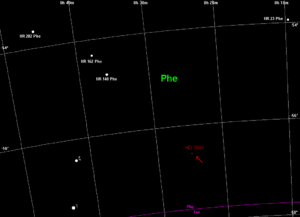HD 2039
|
Stern HD 2039 |
|||||||||||
|---|---|---|---|---|---|---|---|---|---|---|---|

|
|||||||||||
| Position of HD 2039 in the constellation Phoenix | |||||||||||
| AladinLite | |||||||||||
|
Observation dates equinox : J2000.0 , epoch : J2000.0 |
|||||||||||
| Constellation | Phoenix | ||||||||||
| Right ascension | 00 h 24 m 20.28 s | ||||||||||
| declination | -56 ° 39 ′ 0.2 ″ | ||||||||||
| Apparent brightness | 9 likes | ||||||||||
| Typing | |||||||||||
| Known exoplanets | 1 | ||||||||||
| Spectral class | G2 / G3 IV / V | ||||||||||
| Astrometry | |||||||||||
| Radial velocity | (8.5 ± 0.3) km / s | ||||||||||
| parallax | (9.75 ± 0.95) mas | ||||||||||
| distance | (335 ± 33) ly (103 ± 10) pc |
||||||||||
| Visual absolute brightness M vis | +3.95 likes | ||||||||||
| Proper movement | |||||||||||
| Rec. Share: | (78.42 ± 0.70) mas / a | ||||||||||
| Dec. portion: | (15.22 ± 0.78) mas / a | ||||||||||
| Physical Properties | |||||||||||
|
Other names and catalog entries |
|||||||||||
|
|||||||||||
| annotation | |||||||||||
|
|||||||||||
HD 2039 is a star of the spectral class G in the constellation Phoenix . The apparent brightness of the star is 9 mag, so the object can only be seen with telescopes . The distance of the star from the sun is about 300 light years . Around HD 2039, a spectroscopic companion was discovered that could be an exoplanet.
companion
Main article: HD 2039 b
As part of the AAPS (Anglo-Australian Planet Search) program, a spectroscopic companion of HD 2039 was discovered, which was given the systematic name HD 2039 b .
literature
- Tinney et al .: Four New Planets Orbiting Metal-Enriched Stars . In: The Astrophysical Journal . 587, No. 1, 2003, pp. 423-428.
- Butler et al. : Catalog of Nearby Exoplanets . In: The Astrophysical Journal . 646, No. 1, 2006, pp. 505-522. (Preprint arxiv : astro-ph / 0607493 )
Web links
- HD 2039 + HD 2039 b. The Extrasolar Planets Encyclopaedia
- HD 2039 + HD 2039 b. Extrasolar Visions
- HD 2039 + HD 2039 b. SIMBAD
Individual evidence
- ↑ a b c Hipparcos catalog (ESA 1997)
- ↑ Pulkovo radial velocities for 35493 HIP stars
- ↑ a b c Hipparcos, the New Reduction (van Leeuwen, 2007)